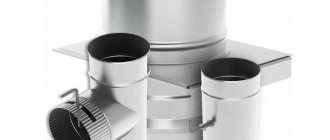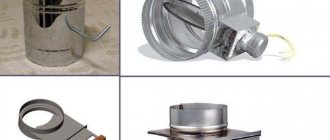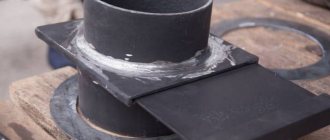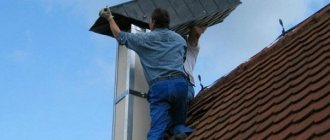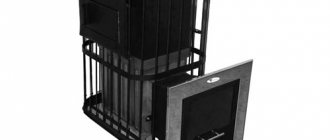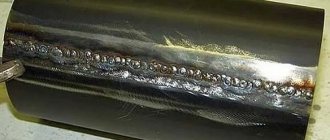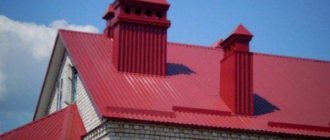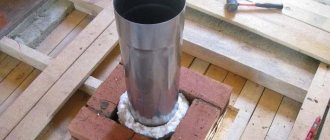The efficient operation of stove equipment in a bathhouse or private house depends on the chimney. From there, oxygen-rich air, necessary for active combustion of the fuel, enters the firebox. Smoke, soot and exhaust gases are removed through the pipe. Gas exchange in the chimney is based on the draft force - the pressure difference in the upper and lower sections of the chimney.
At the top, the movement of air masses occurs more actively, as a result of which an area of low pressure is formed there. Due to this, the smoke from the firebox rises up the chimney by force of traction and comes out. But under normal conditions, heat will also come out of the stove along with smoke and carbon monoxide. To hold it, as well as regulate combustion and draft, a damper is used inside the chimney.
What is it and what is it for?
Damper (from the German Schieber - damper) is a device for completely or partially blocking the movement of gases in the chimney. It has been used since the appearance of the first Russian stoves. Made from cast iron or steel. In modern engineering it has found application both in smoke exhaust structures and in ventilation systems.
Damper functions:
- Regulating draft and maintaining heat in the room.
The chimney is closed after use to prevent warm air from being drawn from the room into the chimney. Using a damper, you can reduce or increase the working cross-section of the chimney.
- Saving fuel consumption.
The valve can be used to regulate the intensity of oxygen flow to the flame, and accordingly increase or decrease the efficiency of the heater.
This statement is true only for furnaces and boilers without blowers and forced air supply devices.
Difference in models depending on material
Various materials can be used for the production of chimney valves: cast iron and steel. They have shown the most reliable performance characteristics, allowing them to be resistant to high temperatures.
Cast iron
Quite durable and long service life. Disadvantages:
- heavy weight, which increases the load on the structure;
- difficulties encountered during installation;
- in case of use in wet conditions - poor corrosion resistance.
Used in chimneys made of brick base.
Stainless steel
A device made from this material belongs to the universal category. Excellent for installation in stoves, fireplaces and chimneys made of brick (pre-lined with a stainless steel pipe) or metal.
Steel structures have a simpler appearance, but are not much inferior to cast iron in properties. Their significant advantage is their light weight, which reduces the load. In addition, they are mounted on all kinds of chimneys (rectangular and oval, heavy, made of brick, etc.). When choosing a damper for a furnace, you will need to take into account not only the operational properties, but also the overall interior of the room.
How the gate works
Structurally, the gate is a locking device with an adjustable valve. It is thanks to the displacement of the valve that the movement of gases in the chimney is regulated. Can be installed in chimneys of round, square and rectangular cross-section. It is a metal plate that moves inside the smoke channel in a certain way.
Gate valves can be of two types:
- Retractable. Moves in one plane back and forth.
- Rotary. Regulates air access by rotating around its axis.
In addition, valves can be manual or equipped with an electric drive. The cost of the latter is an order of magnitude higher and they are not used in chimneys.
Damper functions
It is a thin metal plate that is manually adjusted using a special handle.
Depending on the design and type of damper, it is installed using a metal frame or inserted inside the chimney and secured with a rod.
Do not think that the gate is capable of sealing the pipe completely. According to fire safety regulations, there must be a hole in it through which a small gas exchange takes place.
The gate performs the following functions:
- increased traction force in bad weather;
- fuel economy due to reduced combustion intensity;
- preventing heat loss after the heater has warmed up.
If combustion in the furnace occurs when supply air is supplied, then a gate valve does not need to be installed.
Types and designs
The chimney damper is available in several versions.
Retractable
It is a round or rectangular frame with a plate. The plate extends and retracts, thereby adjusting the cross-section of the chimney.
This option is most often used with brick and ceramic channels. To ensure incomplete sealing and avoid carbon monoxide poisoning, a small hole is made in the plate. The main advantage of this option is ease of installation.
Rotary throttle
A rotary or throttle valve (also known as a hog valve) is a plate made of steel or cast iron that rotates around an axis. The axis is a metal rod welded inside the chimney. Used in steel chimneys.
It is less reliable - over time, the welding fastening of the plate and axle weakens. You should avoid installing a rotary damper in the bathhouse - even when closed, this type of damper partially allows steam to pass through.
In addition, gate valves differ in material (the most common are stainless steel and cast iron) and the method of adjustment.
Differences between retractable and rotary gates
The retractable damper allows you to adjust the working cross-section of the chimney, while the rotary damper only allows you to open or close the pipe. Of course, some tricks are possible - such as securing the hog in an intermediate position in different ways, but the factory equipment does not provide for this. In addition, the rotary gate complicates mechanical cleaning of the pipe.
The hog is often installed in metal chimneys, and the retractable one is installed in brick chimneys.
Home manufacturing technology
Qualified specialists always emphasize that even a novice craftsman can make a rotary and retractable gate. After all, in order for the finished product to perfectly cope with its main task, you need to correctly take all the necessary measurements
If the finished damper fits tightly into the chimney, then over time it may jam, as it will be exposed to high temperature. And when there is a large gap between the valve and the pipe, it will be difficult to regulate the intensity of the draft during operation.
Multifunctional butterfly valve
To make this type of gate, you need to use a steel angle of 30x30 mm, as well as durable sheet steel, the thickness of which is at least 1.5 millimeters. The manufacturing process itself consists of several main stages, which must be implemented in strict sequence:
- Initially, you need to take measurements of the inside of the chimney. This is done in order to avoid mistakes during the manufacture of a frame from a corner, which is fixed with a welding machine.
- On one side of the frame, exactly in the center, you need to drill a small hole (7-8 mm in diameter). It will be useful for the rotary axis.
- A similar hole must be made on the other side of the frame.
- The plate for the damper must be cut from a steel sheet. This part must fully correspond to the internal dimensions of the manufactured frame.
- To make a guide axis, you need to take a piece of wire with a diameter of 9 mm and a length that will exceed the size of the frame itself by 7 cm. You need to cut a thread on one side of the wire (a die is best for this task).
- The finished axle is carefully threaded into the holes on the frame and secured with a nut.
- All cuts on the plate are processed with a grinding machine and inserted into the frame.
- At this stage, the master must weld the axle exactly in the center of the plate.
- All that remains is to make a comfortable handle for the guide from high-quality scrap materials.
Universal device
Modern gate valves include the valve itself, as well as a special guide frame. That is why, before starting work, the master must measure the internal cross-section of the pipe or brick chimney. In accordance with the available measurements, a neat rectangle is cut out of sheet steel (5 mm thick). A small longitudinal fold is made on one side, the width of which should not exceed 30 mm.
These manipulations are necessary so that the finished damper can be conveniently pulled out. Each cut must be polished, due to which the dimensions of the product are reduced by 2 mm on each side. Such actions by the technician will ensure free movement of the damper inside the chimney.
When the damper is made for a brick fireplace, the frame itself can be made of thick steel wire, the diameter of which is within 6 mm. During this procedure, the metal blank is simply bent into the shape of the letter P in strict accordance with the existing measurements.
If the chimney has a rectangular shape and is made of steel, then it is better to make the frame from a metal strip 2 mm thick and up to 35 mm wide. The prepared strip is bent lengthwise, leaving a neat gap along the thickness of the plate. Only after this can small cuts be made in two places at an angle of 45° to give the workpiece a U-shape. All gaps in the places of cuts must be butt welded.
To connect the ends of a homemade damper, you need to use two pieces of metal, which should be positioned in such a way that the damper blade can pass freely between them. At the end of all these manipulations, the master should come out with a rectangular frame with grooves for the shutter.
To make a valve in a round pipe, you need to take two identical metal sheets 2 mm thick. Round holes are cut in the center in accordance with the diameter of the chimney. The valve plate must be manufactured separately. After this, the sheets are connected to each other using a welding machine.
It is necessary to weld only three sides around the perimeter so that the holes of the finished valve on the pipe match exactly. A gap of 5 mm must be left between the top and bottom sheets. At this point, the damper manufacturing process can be considered complete, since the craftsman can only insert the valve and secure the finished product to the chimney.
Advantages and disadvantages
Like any engineering solution, a gate has a number of advantages and disadvantages.
Pros:
- Possibility of traction control;
- Fuel economy;
- Dampers help retain heat.
Minuses:
- The devices make it difficult to clean chimneys;
- If installed incorrectly, the gate may jam and negatively affect the movement of gases;
- To make the correct adjustment, you must have some knowledge in the field of smoke exhaust systems.
Adjustment
When operating heating units, an important aspect is the correct adjustment of the traction force, which affects the efficient operation and safety of the heating system. The sliding element, even with full penetration into the chimney channel, does not completely protect the bathhouse from the penetration of carbon monoxide. Closing is carried out after the end of the firebox, the firewood should have time to burn out and become covered with an ash layer.
If this is not followed, there is a risk of inhaling harmful gaseous substances. As carbon monoxide leaks out, it fills the room. It should be remembered that installing draft control devices (vane, deflector, weather vane) does not exempt you from regular cleaning of the pipe. If equipment is not cleared of soot in time, unpleasant consequences cannot be avoided.
It is necessary to carefully monitor the condition of the chimney structure and the presence of sufficient draft force.
To control traction, a formula has been developed for calculating the optimal value for the gate element, which is called the “alpha” coefficient. When setting the required value, uniform combustion of wood materials is ensured with minimal ash formation.
Make it yourself or order it
The choice between a homemade or a ready-made damper should be based on the type of chimney and the degree of its readiness. So, you can install a self-made retractable structure into a ceramic or brick channel.
If we are talking about a stainless chimney that is in the process of assembly, in this case it is better to choose a finished product. The damper is usually included in the chimney system and is mounted using pipe-to-pipe technology, which I will talk about later.
In addition, it is not always possible in the store to select a product specifically for your chimney shape.
Visual demonstration of the efficiency of a gate valve (video)
Closed gate:
Open gate:
In most cases, the gate is made of stainless steel with a thickness of no more than 1 mm. This part can withstand temperatures up to 9000C, is resistant to corrosion and has a low coefficient of thermal expansion.
In order to ensure maximum ease of operation of the chimney and good soot removal, the surface of the damper must be polished.
The joints are joined using the rolling method.
A standard damper covers up to 85% of the chimney, which is the optimal indicator for the effective removal of combustion products.
Making and installing a gate valve with your own hands
Required materials and tools
To independently manufacture and install any type of stainless steel gate, we will need the following tools:
- Bulgarian;
- Abrasive wheels - cutting and grinding;
- Drill;
- Tap and thread lubricant;
- Hammer;
- Pliers;
- Vise;
- Welding and electrodes;
- Kern;
- Roulette;
- Compass;
- Marker.
And materials:
- Stainless steel sheet (preferably domestic brand 12×18n10t, or imported AISI304, they are more expensive, but last an order of magnitude longer).
Sheet thickness 1.5-2.5mm;
- Stainless steel tube 6mm;
- Bolts 8mm -2 pcs;
- Metal rod for the frame.
Drawing and diagrams
Before manufacturing, it is necessary to draw a drawing or diagram of the future valve.
I will give some example diagrams below:
Size calculation
You need to take measurements very carefully; a gap of even a few millimeters can cause the chimney to malfunction.
Actions step by step:
- Using a tape measure, measure the dimensions of the internal section of the channel;
- Add 20-30 mm to the obtained result - you get the outer size of the frame;
- Do not forget to make an opening in the finished valve to release gas;
- The position of the welding holes should be accurately marked.
We summarize the dimensions for the rotary gate in the table:
Installation features
- When installing the gate at the stage of laying brickwork, the frame is placed at a height of 6-8 rows from the base of the pipe;
- The frame should stand straight, without blocking the outline of the chimney;
- In stainless steel chimneys, the valve is installed using the “pipe-to-pipe” technology. It is necessary to coordinate its dimensions with the diameter of the channel;
- An important nuance - the damper is installed on an uninsulated section of the chimney;
- The height from the firebox to the damper should not exceed 1 m (for metal channels);
- Pipe height from the floor to the valve - 1.8 - maximum 2 m (for brick);
- The damper in the grooves should move freely;
Principle of use
In order to reduce the draft, you need to close the damper a little. If, on the contrary, you want to increase traction, you need to open the gate. The principle of use is extremely simple.
The main thing is to choose the right device for your stove and learn how to use it (even though it is very simple). An important nuance is that when the furnace is idle for a long time, you must keep the damper closed to avoid foreign elements getting in there.
The damper also separates the insulated part of the chimney from the non-insulated part. The gate is usually installed at the beginning of the pipe. At the end where the pipes are well insulated, installing a valve is not recommended.
What functions of the damper have we derived?
- With its help, traction is adjusted.
- It protects the chimney from temperature changes.
Frequent errors and problems during installation
- Installation of a valve in an insulated area. Under the influence of thermal expansion, the damper may jam;
- Installation of a cast iron part in a metal chimney (cast iron weighs a lot);
- Using too thin steel or stainless steel with a low nickel content for the manufacture of valves. Such a product quickly deforms under the influence of hot gases and can burn out;
- Installation of a gate with a non-smooth surface;
- Installation of a valve without a hole for carbon monoxide release;
- Installation of handles that do not allow monitoring the position of the valve (applies to rotary elements).
Features of gate maintenance
The gate, made of stainless steel, is usually polished to perfect smoothness. Soot settles on it poorly, but still settles. Therefore, it must be cleaned periodically.
The horizontal valve can be cleaned simply by pulling it out to the maximum and applying a special solution. Rotary - cleaned through the chimney with a special plastic brush. You should also ensure that the damper moves freely along the guides. It is allowed to periodically lubricate them with an anti-corrosion compound.
Varieties
Gate valves come in sliding and rotary types. The first works due to the perpendicular movement of the partition. The second type involves a rotating mechanism located inside the chimney.
Retractable
This type of gate is a comfortable and effective way to control traction. Its main difference is its long service life, which is achieved by the absence of temporary wear at the attachment points. Due to this, it is possible to maintain the high quality of the damper even in bad weather conditions.
Turning
The principle of its operation is based on the rotation of the partition about its axis. If you turn it counterclockwise, the damper will close the air flow. If the turn occurs in the opposite direction, then there will be no obstacles in the way of air. To regulate this process, you need to operate a special knob.
In addition, the gate differs in the type of material:
- Cast iron is strong and durable. Typically used in brick chimneys.
- Steel - made of stainless steel, is a universal option for installation in fireplaces, stoves and chimneys.
Expert advice
Where to install the damper on the chimney
There are 3 options for placing the damper relative to the chimney:
- Placement in the firebox of a fireplace or stove;
- Fastening according to the “pipe to pipe” principle;
- Installation in a ventilation pipe.
Let's consider the first 2 options:
- By placing the valve in the furnace firebox or in the outlet pipe
In this case, the damper is located at a height of no more than 1 m from the firebox, on an uninsulated section of the pipe. This location is convenient for adjusting the damper.
- Pipe in pipe
Applicable for metal chimneys. This installation option does not require additional fasteners. When purchasing a ready-made system, you should install the valve strictly according to the manufacturer’s instructions.
How to adjust traction
Adjusting the draft using a slider is quite simple. By changing the position towards increasing the gap, we increase the flow of air to the fire and the flame flares up stronger. Reduce the gap - traction decreases. The valve is closed after the flame has completely died out - this way the oven cools down much faster.
The latest boiler models are made with built-in automatic baffles. All other heating units require the mandatory installation of a damper.
Deflector for the chimney pipe (with photo)
To eliminate backdraft in the chimney, it is recommended to use a deflector.
>
Look at the photo: the chimney deflector is a mechanical fan that sucks smoke from the chimney shaft.
It is also necessary to look at how the gate is located - a special valve with which the draft is controlled. One damper should be located in the chimney duct, and the second, as a rule, is located either in the stove or in its door. You can try changing their position.
Modern deflectors for stoves are:
with a flat top;
equipped with an opening lid;
having a gable roof with two slopes on the pipe;
with a semicircular top.
Deflectors with a flat copper top are often located in Art Nouveau style baths.
Basically, sheets of galvanized iron are used to make deflectors, although recently you can often find deflectors on sale in which the metal is coated with enamel or even a layer of plastic.
Some models of deflectors must be inserted with the door facing the smoke collector. To do this, you need to place one edge on the wall, carefully lift the second and lower it into place. For ease of installation, the plates should be removed from the rear and side walls.
You can choose a model in a store, or you can easily make a chimney deflector yourself. Before making a deflector for a pipe, read the detailed description of the stages of work.
Before you begin directly making the deflector, you need to decide on the material from which it will be made. It can be copper, galvanized iron or stainless steel. Despite the fact that copper is a fairly expensive material, it is better to opt for this metal, as it is resistant to atmospheric conditions. This is due to the fact that the deflector is located in one of the most inaccessible places in the bathhouse, and frequent repairs will be problematic.
Before making the deflector, it is necessary to draw on cardboard a development of all the main parts, including the cap, diffuser and outer cylinder. Then you should transfer everything to metal and cut according to these patterns using special scissors. Next, you need to connect the parts to each other using rivets, bolts or welding. From a strip of metal you need to make brackets with which the cap will be fixed to the surface. A reverse cone should be attached to the cap. Having assembled the deflector onto the chimney pipe, you can proceed to installing it on the roof. First you need to fix the lower cylinder using bolts and nuts. Using clamps, you need to secure the diffuser to the lower cylinder, and install a cap with a reverse cone on it.
